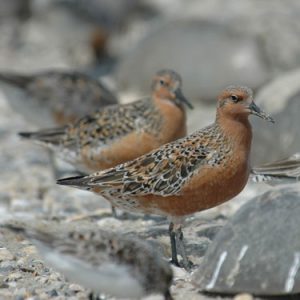
Speculation that red knot abundance is directly tied to horseshoe crab populations is in part supported by new scientific research, according to a U.S. Geological Survey- led study published in Ecosphere, a journal of the Ecological Society of America.
Red knot populations have plummeted over the last 15 years, coinciding with decreased numbers of egg-laying horseshoe crabs in Delaware Bay.
The research bolsters the hypothesis that managing horseshoe crab populations and their harvest may help conserve red knots. Most horseshoe crab harvest today comes from the fishing industry, which uses the crab as bait, and the pharmaceutical industry, which collects their blood for its clotting properties.
The study, which looked at data from more than 16,000 birds over a 12-year period, revealed that the chance of a red knot gaining significant weight after arriving at Delaware Bay is directly related to the estimated number of female horseshoe crabs that spawned during the shorebird stopover period each spring. Birds that do not gain enough weight tend to have a lower chance of surviving the rest of the year, and in some years the difference between heavy and light bird survival can be large.
Horseshoe crab spawning is driven not only by tides and lunar cycles, but also by water temperatures and wave-generating storms. This means that if water temperatures or storm frequency in the mid-Atlantic region change significantly because of climate change, the timing of egg spawning would likely also change and become mismatched with when red knots and other shorebirds arrive to feed on the nutrient-rich eggs. Shorebirds depend primarily on celestial cues for when to migrate and are not as susceptible to environmental variation as horseshoe crabs, making a mismatch more possible.
The research also found evidence that the annual survival of these birds is not only partly dependent on their body mass when they leave Delaware Bay but is also strongly related to snow conditions when the birds reach their arctic breeding grounds.
The study has important management implications for both species. “These results indicate that managing horseshoe crab resources in the Delaware Bay has the potential to improve red knot population status,” Conor McGowan (USGS) said. McGowan and other USGS scientists have been working with the U.S. Fish and Wildlife Service, state fish and wildlife agencies, and the Atlantic States Marine Fisheries Commission to develop a horseshoe crab harvest adaptive management plan that incorporates the results of this survival analysis study.
The research, Demographic consequences of migratory stopover: linking red knot survival to horseshoe crab spawning abundance, was authored by Conor McGowan (USGS), James Hines (USGS), James Nichols (USGS), James Lyons (U.S. Fish and Wildlife Service) and others. It was published in this month’s edition of Ecosphere, a new open-access journal of the Ecological Society of America. The article is available online.
source: U.S. Geological Survey